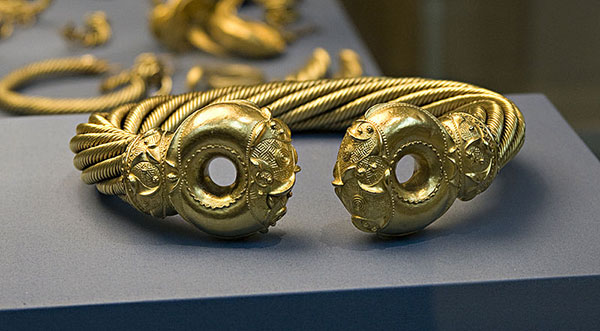La Tene art is evidence that those known as the Celts were a highly artistic people and, contrary to contemporary literature, a great civilisation.
La Tene, a site beside Lake Neuchatel in central Switzerland has come to mean both a style of Celtic artwork and also a period of European history, approximately 600 – 100 BCE.
The artwork was originated by a small group of Celts living in central Europe and through the migrations of the tribes and trade with other cultures spread across the continent.
It is a particular style of artwork, metalwork that ignored realism and delved into worlds of fantasy and abstract. The artefacts were beautifully designed and crafted, firstly carved in wood or modelled in wax before being cast in bronze. Later they were inlaid with coral, enamel and glass. Metal bowls, helmets, swords and flagons, mostly discovered in burial grounds, were decorated with a highly sophisticated level of skill.
The Great Civilisation that was the Celts
At first, the designs were based on previous Hallstatt traditions, repetitive triangles and lozenges, but gradually the influence of the eastern Mediterranean and the Etruscans began to emerge. Although influenced by other styles, the fantastic images of the natural world that emerged ensured that La Tene was a unique form of artwork attributed to the Celts.
La Tene denotes a period of wealth and power to the Celts, a culture which had influence, wealth and skill. It is evident that they were the dominant culture across great swathes of Europe, and that they were mobile and that, contrary to the writings of many contemporary Greeks and Romans, they were a great civilisation.
Religious Irish Celtic Art
Irish Celtic art continued long after it had disappeared in other Celtic territories. The Christian church influenced much of the artwork, so that most of the artefacts from that period are of a religious context. All work must be carried out in the name of the Lord, and it was not until the Renaissance that princes again became patrons of the arts.
Except for the illuminated manuscripts and carved crosses, later Celtic art was a mixture of La Tene, Roman and Anglo Saxon designs. It continued to be principally a metalworker’s craft with coloured glass and enamel added for decoration.
Many of the artefacts such as chalices and drinking cups were produced in monasteries that were under the control of the church. The Ardagh Chalice, discovered in County Limerick, is a silver cup with the names of the Apostles inscribed on the outside. It was probably used for the drinking of wine during Mass. Its decoration is similar to that on the Tara Brooch, a famous and exquisite piece of Celtic jewellery.
The few objects that were non-religious were everyday clothes fastenings, such as pins and brooches.
Viking Raids and Norman Invasion
As Viking raids became more common, jewelery and objects became less decorated and ornate and the quality of craftsmanship declined. Artwork displayed a more Scandinavian influence, almost eclipsing Celtic style. The Norman invasion dispersed the Vikings and the Irish artisans again were exposed to cultural developments in Western Europe and introduced the new Romanesque style.
Sources:
- Ellis, Peter Berresford, The Celtic Empire 1000BC – 51AD, 1990, Constable and Company Ltd, London
- Wood, J, The Celts: Life, Myth and Art, 1998, Duncan Baird Publishers, London
- Megaw, Ruth and Vincent, Celtic Art: from its beginnings to the Book of Kells, 2001, Thames and Hudson, London








